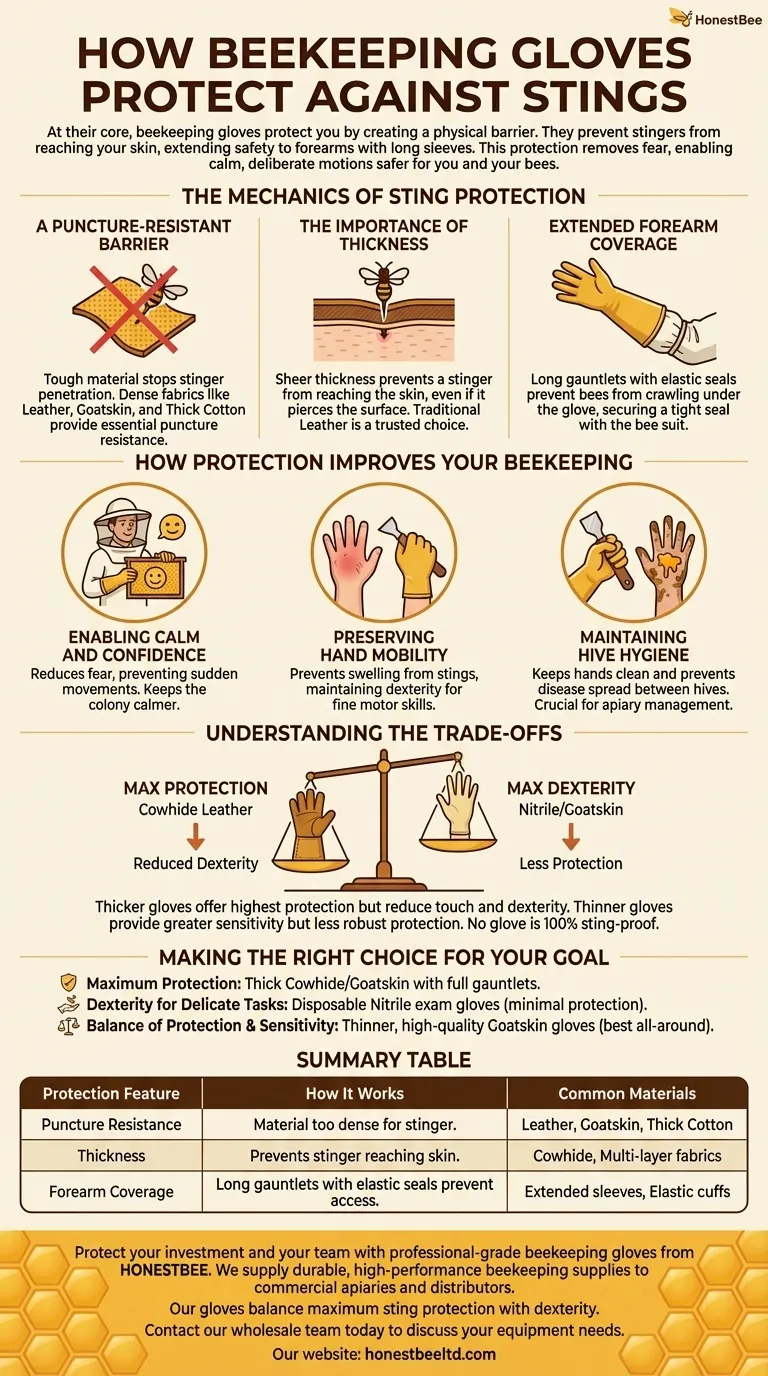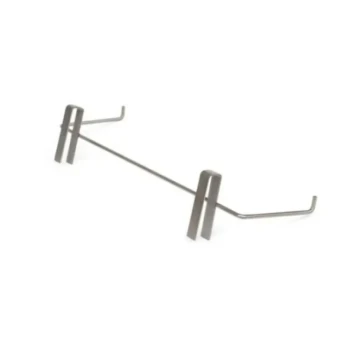At their core, beekeeping gloves protect you by creating a physical barrier. They are constructed from materials thick and durable enough to prevent a bee's stinger from reaching your skin. This protection extends beyond just the hands, with long sleeves that cover the forearms to ensure comprehensive safety while you work.
The true value of beekeeping gloves isn't just preventing pain; it's about enabling confidence. By removing the fear of stings, you can move with calm, deliberate motions, which is safer for you and less stressful for your bees.

The Mechanics of Sting Protection
To understand their effectiveness, we need to look at how beekeeping gloves are designed to function as a shield between you and the bees.
A Puncture-Resistant Barrier
The primary function is simple: the material of the glove is too tough for the stinger to penetrate. Bees have a barbed stinger designed to pierce skin, but it often cannot get through dense materials.
Common materials like leather, goatskin, and thick cotton provide this essential puncture resistance, stopping the sting before it can happen.
The Importance of Thickness
The sheer thickness of the material is a critical factor. Even if a stinger could theoretically pierce the material, it may not be long enough to pass through the glove and reach your skin.
This is why traditional beekeeping gloves made of leather are a trusted choice for maximum protection.
Extended Forearm Coverage
Protection doesn't stop at the wrist. Beekeeping gloves feature long sleeves, often called gauntlets, that extend towards the elbow.
These sleeves are typically secured with elastic, ensuring a tight seal with your bee suit or jacket. This design prevents bees from crawling under the glove and gaining access to your arms.
How Protection Improves Your Beekeeping
Effective gloves do more than just prevent pain; they fundamentally change how you interact with your hives, leading to better beekeeping practices.
Enabling Calm and Confidence
When you are not worried about being stung, you are less likely to make sudden, jerky movements that bees perceive as a threat.
This confidence allows you to perform hive inspections and other tasks with a steady hand, which keeps the colony calmer and reduces defensive behavior.
Preserving Hand Mobility
A bee sting on the hand often causes significant swelling. This can severely reduce your fine motor skills and make it difficult or impossible to continue working.
By preventing stings, gloves ensure you maintain the dexterity needed to handle frames and equipment carefully.
Maintaining Hive Hygiene
Beyond sting protection, gloves also keep your hands clean from sticky honey and propolis.
More importantly, they can be a crucial tool in preventing the spread of diseases between hives. Using clean gloves for each hive is a key principle of good apiary management.
Understanding the Trade-offs
No piece of equipment is perfect. Choosing the right glove involves balancing absolute protection with the practical needs of working with bees.
Protection vs. Dexterity
This is the central trade-off. Thicker gloves, like cowhide leather, offer the highest level of sting protection. However, they significantly reduce your sense of touch and dexterity, making delicate tasks more difficult.
Thinner gloves, like goatskin or nitrile, provide much greater sensitivity but offer less robust protection against a determined bee.
The Myth of "Sting-Proof"
It is important to understand that no glove is 100% sting-proof. A highly agitated bee may still manage to sting through certain materials or find a small gap.
Quality construction and proper fit are essential to maximizing the glove's protective capabilities.
Making the Right Choice for Your Goal
Your choice of glove should align with your comfort level and the specific tasks you need to perform.
- If your primary focus is maximum protection: Choose thick cowhide or goatskin leather gloves with full gauntlets.
- If your primary focus is dexterity for delicate tasks: Consider using disposable nitrile exam gloves, but understand they offer minimal sting protection.
- If your primary focus is a balance of protection and sensitivity: Thinner, high-quality goatskin gloves are often the best all-around option for most beekeepers.
Ultimately, the right beekeeping gloves empower you to be a more effective and confident caretaker of your colonies.
Summary Table:
| Protection Feature | How It Works | Common Materials |
|---|---|---|
| Puncture Resistance | Material is too dense for a bee's stinger to penetrate. | Leather, Goatskin, Thick Cotton |
| Thickness | Prevents the stinger from reaching the skin, even if it pierces the surface. | Cowhide, Multi-layer fabrics |
| Forearm Coverage | Long gauntlets with elastic seals prevent bees from accessing the arms. | Extended sleeves, Elastic cuffs |
Protect your investment and your team with professional-grade beekeeping gloves from HONESTBEE. We supply durable, high-performance beekeeping supplies and equipment to commercial apiaries and distributors. Our gloves are designed to balance maximum sting protection with the dexterity needed for efficient hive management. Contact our wholesale team today to discuss your equipment needs and ensure your operation runs smoothly and safely.
Visual Guide

Related Products
- Vented Beekeeping Jacket with Hood and Veil for Beekeepers
- 3 Layer Mesh Vented Sting Proof Beekeeping Suit with Hat and Veil
- Cotton Beekeeping Suit and Round Hat with Veil Bee Keeper Protective Gear
- Yellow Plastic Bucket Pail Perch for Beekeeping
- Heavy-Duty Stainless Steel Clip-On Frame Perch
People Also Ask
- What features should be considered for sting protection in a beekeeping suit? Ensure Total Safety and Comfort
- How should one choose a beekeeping suit? Find the Perfect Balance of Protection & Comfort
- Why is it important to regularly clean a beekeeping suit? Prevent Bee Attacks and Protect Your Investment
- What should be considered when purchasing a ventilated bee suit? Ensure Maximum Safety and Comfort
- What should be considered regarding the color of beekeeping clothing? Ensure Your Safety and Keep Bees Calm



















